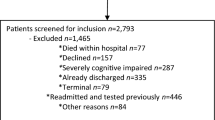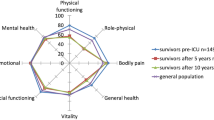Abstract
Purpose
Estimating the probability of readmission following hospitalization using prediction scores can be complex. Quality of life (QoL) may provide an easy and effective alternative.
Methods
Secondary analysis of the prospective “TRIAGE” cohort. All medical in-patients admitted to a Swiss tertiary care institution (2016–2019) ≥18 years with a length of stay of ≥2 days (23,309 patients) were included. EQ-5D VAS, EQ-5D index, and Barthel index were assessed at a single telephone interview 30-day after admission. Patients lost to follow-up were excluded. Readmission was defined as a non-elective hospital stay at our institution >24 h within 1 year after discharge and assessed using area under the curve (AUC) analysis with adjustment for confounders.
Results
12,842 patients (43% females, median age 68, IQR 55–78) were included. Unadjusted discrimination was modest at 0.59 (95% CI 0.56–0.62) for EQ-5D VAS. Partially adjusted discrimination (for gender) was identical. Additional adjustment for insurance, Charlson comorbidity index, length of stay, and native language increased the AUC to 0.66 (95% CI 0.63–0.69). Results were robust irrespective of time to event (12, 6 or 3 months). A cut-off in the unadjusted model of EQ-5D VAS of 55 could separate cases with a specificity of 80% and a sensitivity of 30%.
Conclusion
QoL at day 30 after admission can predict one-year readmission risk with similar precision as more intricate tools. It might help for identification of high-risk patients and the design of tailored prevention strategies.


Similar content being viewed by others
Data availability
Due to national laws data can only be made available on receipt of a letter of intention detailing the study hypothesis and statistical analysis plan. The steering committee of this study will discuss all requests and decide on the basis of the scientific rigor of the proposal whether data sharing is appropriate. All applicants are asked to sign a data access agreement. Please send any request to the corresponding author.
References
Zhou, H., Della, P. R., Roberts, P., Goh, L., & Dhaliwal, S. S. (2016). Utility of models to predict 28-day or 30-day unplanned hospital readmissions: An updated systematic review. British Medical Journal Open, 6(6), e011060. https://doi.org/10.1136/bmjopen-2016-011060
Schuetz, P., Aujesky, D., Muller, C., & Muller, B. (2015). Biomarker-guided personalised emergency medicine for all – hope for another hype? Swiss Medical Weekly, 145, w14079. https://doi.org/10.4414/smw.2015.14079
Donze, J., Aujesky, D., Williams, D., & Schnipper, J. L. (2013). Potentially avoidable 30-day hospital readmissions in medical patients: Derivation and validation of a prediction model. JAMA Internal Medicine, 173(8), 632–638. https://doi.org/10.1001/jamainternmed.2013.3023
Barnett, K., Mercer, S. W., Norbury, M., Watt, G., Wyke, S., & Guthrie, B. (2012). Epidemiology of multimorbidity and implications for health care, research, and medical education: a cross-sectional study. [Research Support, Non-U.S. Gov’t]. Lancet, 380(9836), 37–43. https://doi.org/10.1016/S0140-6736(12)60240-2
Mercer, S. W., Guthrie, B., Furler, J., Watt, G. C., & Hart, J. T. (2012). Multimorbidity and the inverse care law in primary care [Editorial]. BMJ, 344, e4152. https://doi.org/10.1136/bmj.e4152
Leppin, A. L., Gionfriddo, M. R., Kessler, M., Brito, J. P., Mair, F. S., Gallacher, K., Wang, Z., Erwin, P. J., Sylvester, T., Boehmer, K., Ting, H. H., Hassan Murad, M., Shippee, N. D., & Montori, V. M. (2014). Preventing 30-day hospital readmissions: A systematic review and meta-analysis of randomized trials. JAMA Internal Medicine, 174(7), 1095–1107. https://doi.org/10.1001/jamainternmed.2014.1608
Allard, J. P., Keller, H., Teterina, A., Jeejeebhoy, K. N., Laporte, M., Duerksen, D. R., Gramlich, L., Payette, H., Bernier, P., Davidson, B., & Lou, W. (2016). Lower handgrip strength at discharge from acute care hospitals is associated with 30-day readmission: A prospective cohort study. Clinical Nutrition, 35(6), 1535–1542. https://doi.org/10.1016/j.clnu.2016.04.008
Andreasen, J., Aadahl, M., Sorensen, E. E., Eriksen, H. H., Lund, H., & Overvad, K. (2018). Associations and predictions of readmission or death in acutely admitted older medical patients using self-reported frailty and functional measures. A Danish cohort study. Archives of Gerontology and Geriatrics, 76, 65–72. https://doi.org/10.1016/j.archger.2018.01.013
Hertzberg, D., Luksha, Y., Kus, I., Eslampia, P., Pickering, J. W., & Holzmann, M. J. (2020). Gait speed at discharge and risk for readmission or death: A prospective study of an emergency ward population. Open Access Emerg Med, 12, 127–135. https://doi.org/10.2147/OAEM.S229479
van Hout, B., Janssen, M. F., Fen, Y. S., Kohlmann, T., Busschbach, J., Golicki, D., Lloyd, A., Scalone, L., Kind, P., Simon, A., & Pickard. . (2012). Interim scoring for the EQ-5D-5L: Mapping the EQ-5D-5L to EQ-5D-3L value sets. Value Health, 15(5), 708–715. https://doi.org/10.1016/j.jval.2012.02.008
Wade, D. T., & Collin, C. (1988). The Barthel ADL Index: A standard measure of physical disability? International Disability Studies, 10(2), 64–67. https://doi.org/10.3109/09638288809164105
Schuetz, P., Hausfater, P., Amin, D., Haubitz, S., Fassler, L., Grolimund, E., Kutz, A., Schild, U., Caldara, Z., Regez, K., Zhydkov, A., Kahles, T., Nedeltchev, K., von Felten, S., De Geest, S., Conca, A., Schäfer-Keller, P., Huber, A., Bargetzi, M., … Mueller, B. (2013). Optimizing triage and hospitalization in adult general medical emergency patients: The triage project [Multicenter Study Observational Study Research Support, Non-U.S. Gov’t]. BMC Emergency Medicine, 13, 12. https://doi.org/10.1186/1471-227X-13-12
Andreasen, J., Gobbens, R. J. J., Eriksen, H. H., & Overvad, K. (2019). Health-related quality of life at hospital discharge as a predictor for 6-month unplanned readmission and all-cause mortality of acutely admitted older medical patients. Quality of Life Research, 28(11), 3015–3024. https://doi.org/10.1007/s11136-019-02259-w
Moons, K. G., Altman, D. G., Reitsma, J. B., Ioannidis, J. P., Macaskill, P., Steyerberg, E. W., Vickers, A. J., Ransohoff, D. F., & Collins, G. S. (2015). Transparent reporting of a multivariable prediction model for Individual Prognosis or Diagnosis (TRIPOD): explanation and elaboration. Annals of Internal Medicine, 162(1), W1-73. https://doi.org/10.7326/M14-0698
Charlson, M. E., Pompei, P., Ales, K. L., & MacKenzie, C. R. (1987). A new method of classifying prognostic comorbidity in longitudinal studies: Development and validation. Journal of Chronic Diseases, 40(5), 373–383. https://doi.org/10.1016/0021-9681(87)90171-8
McPhail, S., Beller, E., & Haines, T. (2008). Two perspectives of proxy reporting of health-related quality of life using the Euroqol-5D, an investigation of agreement. Medical Care, 46(11), 1140–1148. https://doi.org/10.1097/MLR.0b013e31817d69a6
R Core Team (2020). R: A language and environment for statistical computing. R Foundation for Statistical Computing, Vienna, Austria. https://www.R-project.org/
Struja, T., Baechli, C., Koch, D., Haubitz, S., Eckart, A., Kutz, A., Kaeslinutz, M., Mueller, B., & Schuetz, P. (2020). What are they worth? Six 30-day readmission risk scores for medical inpatients externally validated in a Swiss cohort. Journal of General Internal Medicine. https://doi.org/10.1007/s11606-020-05638-z
Uhlmann, M., Lecureux, E., Griesser, A. C., Duong, H. D., & Lamy, O. (2017). Prediction of potentially avoidable readmission risk in a division of general internal medicine. Swiss Medical Weekly, 147, w14470. https://doi.org/10.4414/smw.2017.14470
Tsui, E., Au, S. Y., Wong, C. P., Cheung, A., & Lam, P. (2015). Development of an automated model to predict the risk of elderly emergency medical admissions within a month following an index hospital visit: A Hong Kong experience. Health Informatics Journal, 21(1), 46–56. https://doi.org/10.1177/1460458213501095
Rajkomar, A., Dean, J., & Kohane, I. (2019). Machine learning in medicine. New England Journal of Medicine, 380(14), 1347–1358. https://doi.org/10.1056/NEJMra1814259
Karampampa, K., Frumento, P., Ahlbom, A., & Modig, K. (2016). Does a hospital admission in old age denote the beginning of life with a compromised health-related quality of life? A longitudinal study of men and women aged 65 years and above participating in the Stockholm Public Health Cohort. British Medical Journal Open, 6(7), e010901. https://doi.org/10.1136/bmjopen-2015-010901
Hutchinson, A., Rasekaba, T. M., Graco, M., Berlowitz, D. J., Hawthorne, G., & Lim, W. K. (2013). Relationship between health-related quality of life, and acute care re-admissions and survival in older adults with chronic illness. Health and Quality of Life Outcomes, 11, 136. https://doi.org/10.1186/1477-7525-11-136
Belayachi, J., El Khattate, A., Bizrane, M., Madani, N., & Abouqal, R. (2018). Pre-admission quality of life as predictor of outcome after acute care: The role of emotional well-being. QJM, 111(2), 111–115. https://doi.org/10.1093/qjmed/hcx209
Dhaussy, G., Drame, M., Jolly, D., Mahmoudi, R., Barbe, C., Kanagaratnam, L., Nazeyrollas, P., Blanchard, F., Novella, J. L., & SAFES Group. (2012). Is health-related quality of life an independent prognostic factor for 12-month mortality and nursing home placement among elderly patients hospitalized via the emergency department? Journal of the American Medical Directors Association, 13(5), 453–458. https://doi.org/10.1016/j.jamda.2011.10.002
Pearson, S., Stewart, S., & Rubenach, S. (1999). Is health-related quality of life among older, chronically ill patients associated with unplanned readmission to hospital? Australian and New Zealand Journal of Medicine, 29(5), 701–706. https://doi.org/10.1111/j.1445-5994.1999.tb01618.x
Parlevliet, J. L., MacNeil-Vroomen, J., Buurman, B. M., de Rooij, S. E., & Bosmans, J. E. (2016). Health-related quality of life at admission is associated with postdischarge mortality, functional decline, and institutionalization in acutely hospitalized older medical patients. Journal of the American Geriatrics Society, 64(4), 761–768. https://doi.org/10.1111/jgs.14050
Kirby, S. E., Dennis, S. M., Jayasinghe, U. W., & Harris, M. F. (2010). Patient related factors in frequent readmissions: The influence of condition, access to services and patient choice. BMC Health Services Research, 10, 216. https://doi.org/10.1186/1472-6963-10-216
Funding
This study was supported in part by the Swiss National Science Foundation (SNSF Professorship, PP00P3_150531/1), the Research Council of the Kantonsspital Aarau (1410.000.044) on behalf of PS, and by the “Elsa and Hugo Isler-Fonds” of the Argovian Department of Health and Social Affairs on behalf of TS. Dr. Siepmann received grants from the German Federal Ministry of Health, the Michael J. Fox Foundation, the German Parkinson Association and the Kurt Goldstein Institute that were not related to this study. Funders had no role in the design, analysis or writing of this article.
Author information
Authors and Affiliations
Contributions
This work is part of a Master’s thesis of the Master’s Program in Clinical Research, Center for Clinical Research and Management Education, Division of Health Care Sciences, Dresden International University, Dresden, Germany. TS and PS had full access to all the data in the study and takes responsibility for the integrity of the data and the accuracy of the data analysis.
Corresponding author
Ethics declarations
Conflict of interest
All authors confirm that they do not have a conflict of interest associated with this manuscript.
Ethical approval
Approval was obtained from the institutional review board of Northwestern Switzerland (EKNZ) (IRB reference number: EKNZ 2012/059); the need for individual informed consent was waived due to the retrospective nature of this analysis.
Consent to participate
All participants had the option to withdraw from the study any time given. Also, they could answer only the question they felt appropriate.
Consent for publication
Not applicable.
Additional information
Publisher's Note
Springer Nature remains neutral with regard to jurisdictional claims in published maps and institutional affiliations.
Supplementary Information
Below is the link to the electronic supplementary material.
Rights and permissions
About this article
Cite this article
Struja, T., Koch, D., Haubitz, S. et al. Quality of life after hospitalization predicts one-year readmission risk in a large Swiss cohort of medical in-patients. Qual Life Res 30, 1863–1871 (2021). https://doi.org/10.1007/s11136-021-02867-5
Accepted:
Published:
Issue Date:
DOI: https://doi.org/10.1007/s11136-021-02867-5




